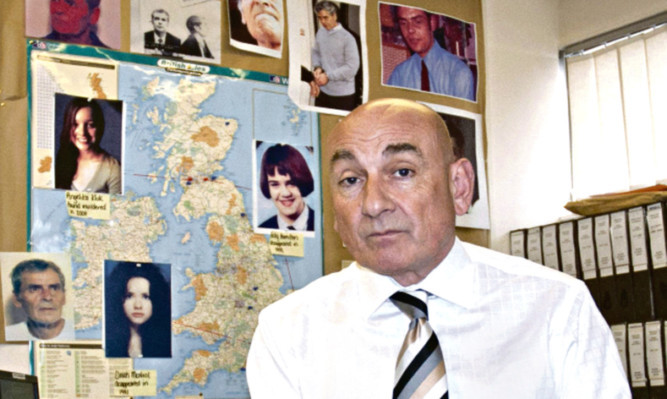
Former DCI David Swindle has left the police and is now one of the country’s top private detectives.
Looking back on an impressive career which saw him tasked with countless murder inquiries, he says the chilling chase of multiple killer Tobin stands out as a grim “highlight”.
The no-nonsense 60-year-old is already being flooded with work as a sleuth-for-hire, no doubt due to the fact he has one of the biggest cases in British police history on his CV.
Swindle recalls the events of nearly 10 years ago and has revealed it was his gut instinct as one of the then Strathclyde force’s elite officers that set him on the trail of Tobin.
He was called to St Patrick’s RC Church in Glasgow back in September 2006 after the body of murdered Polish woman Angelika Kluk was found hidden under the floorboards.
“The ferocity of the murder and the fact that everything had been hidden down there made me realise he’d done this before,” said Swindle.
After snaring Tobin thanks to a DNA link and nationwide manhunt, the officer launched Operation Anagram to look for other victims. It took the investigating team to a previous address Tobin had lived at in Margate, Kent. There in a lonely shallow grave they found the bodies of missing Scottish teenager Vicky Hamilton, 15, and backpacker Dinah McNicol, 18. Cold blooded Tobin had buried them in the back garden.
Following an appeal on the BBC’s Crimewatch programme, Sussex Police excavated a hotel in Brighton where Tobin stayed in the 1980s, but didn’t find any more bodies.
Meanwhile, the team working on the operation also re-examined unsolved cases, including the Bible John murders which gripped Glasgow in the 1960s.
Everything was taken into account. Mr Swindle’s team painstakingly picked apart Tobin’s personal history and discovered a deeply troubled character right from the start.
“Tobin was just a bad man all through his life,” he said. “He had been in Borstal as a young person and had been committing crime from a very young age.”
His first wife, the 17-year-old Margaret Mountney, was horrified when he took an axe to their pet puppy. Tobin chopped its head off while she had been out shopping because he was fed up with it yapping. “That is what you would call an early indicator of a serial killer at a very young age,” Swindle said. “He was always an evil and calculating man. I still live in hope that new evidence about Tobin’s other crimes will come to light. There is absolutely no question that Tobin has killed more people.”
Swindle has spent a life dealing with hard facts and evidence. And the fact there’s no evidence linking Tobin to the Bible John dance-hall murders means he’ll never be able to put the two together.
“There has been speculation about Tobin being Bible John and we believe that Tobin did rape people in the 60s in Glasgow, as well as committing other crimes. But there is nothing to say it was him. The Police deal in evidence and there is no indication that he was ever involved in any of the Bible John killings. I believe it would be unfair on the families of the victims to suggest that he was.”
There are many similarities between the two cases.
Tobin lived in Glasgow when Bible John’s victims Patricia Docker, 25, Jemima McDonald, 32, and Helen Puttock, 29, were murdered. He was the correct age during 1968-69, and was often at the city’s Barrowland ballroom, where he met his future first wife, who has told of how sadistic Tobin tortured with beatings and strangulation.
The Bible John killings in Glasgow stopped after Helen Puttock’s murder. Many believe this is significant as it dovetails with Tobin leaving Glasgow to travel around Britain.
But Mr Swindle, 60, said the way the two men operated differed. “Tobin was a groomer. He didn’t attack like Bible John did. The media speculation over whether Tobin is Bible John has clouded quite a few things that we have tried to do because it is such a powerful theory.
“It is easy for people to say Tobin is Bible John, but where is the evidence?”

Enjoy the convenience of having The Sunday Post delivered as a digital ePaper straight to your smartphone, tablet or computer.
Subscribe for only £5.49 a month and enjoy all the benefits of the printed paper as a digital replica.
Subscribe